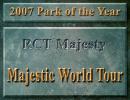| Main Site |
|
Home Site Charter Forums |
| Vacation Park |

|
| Game News |
|
RCT2 Announced Screenshots New Features Interviews |
| Community |
|
Ride Exchange Ride Exchange V2.0 Boomer Tribute RCT Station Tribute RCR Feature RCR 2 Feature |
|
|
| Downloads |
|
Steve Franks Track
Packs Steve Franks Carousel Music Steve Franks Bonus Sounds RCT1 Fantasy Parks RCT2 Scenarios Revisited Trainers & Utilities Monthly Contest Winners |
| Reference |
      ShareNet |
| India - Wacky Facts by Scoop |
|
The smell of curry and other exotic spices await us on the next stop of our Wacky Facts tour. The announcement made mention of the Taj Mahal, so here are some facts about this great architectural masterpiece. The Taj Mahal was built of white marble, inlaid with semi-precious stones. It rests on white marble surrounded by four minarets. Floral patterns cover the walls. There are intricate inlays and relief carvings of floral designs. It took about 20,000 workers approximately 20 years from 1630 to 1650 to build the tomb. It was built in memory of Mumtaz Mahal who died in 1629. She was the favorite wife of the Indian ruler, Shah Jahan. Mumtaz Mahal and Shah Jahan's tombs are in the basement of this monument. It is constructed on a platform 22' high and 313' square. The Corner minarets are 137' tall. The Main structure is 186' on a side, with the dome to topping out at 187'. Some European scholars held the view that the Taj was designed by an Italian - Geronimo Veroneo. It is forbidden for aircraft to fly over the Taj Mahal. The Taj Mahal was once scheduled to be torn down in the 1830's. Now, some interesting facts about the country of India. Capital: New Delhi Largest City Calcutta: 9,165,650 Languages: Hindi, English, Telugu, Bengali, Marathi, Tamil, Urdu, Gujarati, Malayalam, Kannada, Oriya, Punjabi, Assamese Population; 843,930,861that's 689 persons per square mile Main Religions: Hinduism, Islam, Christianity, Sikhism, Buddhism, Jainism, Zoroastrianism Area 1.3 million square miles Agriculture Crops: sugarcane, rice, wheat, sorghum, millet, mangoes, corn (maize), peanuts Livestock cattle, buffalo, goats, camels, sheep, poultry Industry: Petroleum products, cement, crude steel, sugar, jute, paper and paperboard, cotton yarn, sulfuric acid, woven cotton fabrics, electric fans, bicycles The official Sanskrit name for India is Bharat, the name of the legendary king in the Mahabhrata. The largest employer in the world is the Indian railway system, employing over a million people. Until 1896, India was the only source for diamonds to the world. ( Source . Gemological Institute of America ) More India facts: The name `India' is derived from the River Indus, the valleys around which were the home of the early settlers. The Aryan worshippers referred to the river Indus as the Sindhu. The number system was invented in India. Aryabhatta was the scientist who invented the digit zero. Sanskrit is considered as the mother of all higher languages. This is because it is the most precise, and therefore suitable language for computer software. ( a report in Forbes magazine, July 1987 ). Perhaps the most popular of all India's culinary exports, the curry was recently named as the most popular dish in Britain. Curry derives it's name from 'kadi', the Tamil word for sabzi (or vegetable). In some parts of the world, going for a 'curry and a beer' are an intrinsic part of a good 'night out'. Chess was invented in India. The' place value system' and the 'decimal system' were developed in 100 BC in India. The first six Mogul Emperor's of India ruled in an unbroken succession from father to son for two hundred years, from 1526 to 1707. The World's First Granite Temple is the Brihadeswara temple at Tanjavur in Tamil Nadu. The shikhara is made from a single ' 80-tonne ' piece of granite. Also, this magnificient temple was built in just five years, (between 1004 AD and 1009 AD) during the reign of Rajaraja Chola The game of snakes & ladders was created by the 13th century poet saint Gyandev. It was originally called 'Mokshapat.' The ladders in the game represented virtues and the snakes indicated vices. The game was played with cowrie shells and dices. Later through time, the game underwent several modifications but the meaning is the same i.e good deeds take us to heaven and evil to a cycle of re-births. Although modern images & descriptions of India often show poverty, India was one of the richest countries till the time of British in the early 17th Century. Christopher Columbus was attracted by India's wealth and was looking for route to India when he discovered America by mistake. The art of Navigation & Navigating was born in the river Sindh 6000 over years ago. The very word 'Navigation' is derived from the Sanskrit word NAVGATIH. The word navy is also derived from the Sanskrit word 'Nou'. The value of "pi" was first calculated by the Indian Mathematician Budhayana, and he explained the concept of what is known as the Pythagorean Theorem. He discovered this in the 6th century, which was long before the European mathematicians. Algebra, trigonometry and calculus also orignated from India. Quadratic equations were used by Sridharacharya in the 11th century. The largest numbers the Greeks and the Romans used were 106 whereas Hindus used numbers as big as 10*53 ( i.e 10 to the power of 53 ) with specific names as early as 5000 B.C. during the Vedic period. Even today, the largest used number is Tera: 10*12( 10 to the power of 12 ). India offers a wide range of adventure sports for tourists. Trekking and Skiing in the Himalayas, White Water Rafting on the Ganges and Beas, Camel and Jeep safaris in the deserts of Rajasthan, Paragliding in Himachal, Water sports in Goa and Scuba Diving in Lakshadweep and Andaman are just some of the options available to the adventure seeking tourists. India also offers it's share of amusement parks. EsselWorld is located at Gorai Village, on the outskirts of the country's biggest metro - Mumbai. Sixty-four sprawling acres of thrills lying along the sparkling surf of the Arabian Sea - it's a most idyllic setting for the largest amusement park in India. Two more parks that are heavily advertised are Veegaland and Appu Ghar. So as we leave this magical and mysterious land of India, one can only wonder is Mr. Sawyer going to give us elephants, tigers and cobras to play with. Maybe a minaret or two, or some new food stalls with the ever-present curry. How about the Himalaya or even a Tilt-a-Whirl would be nice. Scoop |
| Awards |
     |
| Off-Site Links |
 |